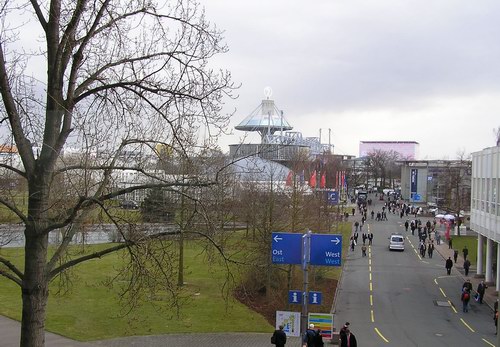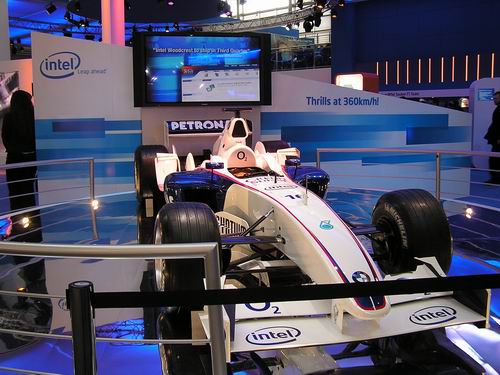Cebit 2006: High end Motherboards and Server News
by Johan De Gelas on March 13, 2006 12:05 AM EST- Posted in
- Trade Shows
Introduction
While Anand and Derek were covering IDF and Intel Conroe Core benchmarking, and Wesley already previewing hardware in Taiwan, the European branch of AnandTech (that is, me) went to Cebit 2006 in Hannover. The main focus of this article is server and related IT subjects, but there were a few cool things that I couldn’t resist, so they ended up in the same report.
Intel
Intel had a very big stand on Cebit, and the showpiece of the booth was one of the Formula one cars of the Intel sponsored BMW Sauber F1 Team. Unless you were the “Bundeskanzlerin” of Germany, you couldn’t enter the supercar.
Woodcrest (Core architecture) and Dempsey (Netburst) are pin compatible and it should be possible to replace a Dempsey CPU with a Woodcrest CPU. However, most server manufactures to whom we spoke, are not so sure. Some said that a new PCB of their motherboard will be necessary, while others said it will be possible only on motherboards that have been validated for Woodcrest (not the current Bensley platforms). But who is going to buy Dempsey when Woodcrest is out?
Virtualisation
Many IT people are looking into virtualisation as a way to make better use of the available server power. However, our own tests in the lab show that software virtualisation is not really easy; it is our experience that guest OS crashes more often on virtualised servers than on real hardware servers. We definitely would advise against running anything mission critical on the current batch of software virtualisation solutions. And Microsoft’s virtual server is not even a real virtual layer - it runs on top of a Windows 2003 server OS. In a nutshell, we are rather sceptical about software virtualisation, and rather have set our hope on hardware virtualisation.
Christian Anderka of Intel confirmed that the current Xeon Paxville and all Xeons (Dempsey, Woodcrest) on the Bensley platform feature hardware virtualisation of the CPU. The CPU gives the “hypervisor” or “virtual layer” a separate and higher privileged mode than the kernel mode in which the current OS run. That should increase the stability of virtualised servers greatly.
Intel announced the next generation of Intel Virtualization Technology (Intel VT) for enterprise servers: Intel Virtualization for Directed I/O (Intel VT-d). VT-d adds support for hardware supported virtualisation of disks and others, but it is very unclear when this technology will be really ready. VT-d includes technology such as hardware DMA remapping and works also on the interrupts level. We will discuss virtualisation later in more detail, but it is clear that VT-D will also need to be supported in PCIe, the chipset components and peripherals.
The quad core Clovertown, which is little more than two (dual core) Woodcrests in the same CPU package, will include this VT-d technology somewhere in 2007. Clovertown is socket-compatible with the Bensley (Dempsey, Woodcrest) platform and is slated to ship in early 2007.
It is, however, also clear that the new instructions that are available in the new highly privileged mode for virtual layers will not be used to their full potential at first. We expect that it will take many releases of newer and improved virtual layers (“hypervisors”) before the new virtual layer instructions are used to their full potential.
While Anand and Derek were covering IDF and Intel Conroe Core benchmarking, and Wesley already previewing hardware in Taiwan, the European branch of AnandTech (that is, me) went to Cebit 2006 in Hannover. The main focus of this article is server and related IT subjects, but there were a few cool things that I couldn’t resist, so they ended up in the same report.

Intel
Intel had a very big stand on Cebit, and the showpiece of the booth was one of the Formula one cars of the Intel sponsored BMW Sauber F1 Team. Unless you were the “Bundeskanzlerin” of Germany, you couldn’t enter the supercar.

Woodcrest (Core architecture) and Dempsey (Netburst) are pin compatible and it should be possible to replace a Dempsey CPU with a Woodcrest CPU. However, most server manufactures to whom we spoke, are not so sure. Some said that a new PCB of their motherboard will be necessary, while others said it will be possible only on motherboards that have been validated for Woodcrest (not the current Bensley platforms). But who is going to buy Dempsey when Woodcrest is out?
Virtualisation
Many IT people are looking into virtualisation as a way to make better use of the available server power. However, our own tests in the lab show that software virtualisation is not really easy; it is our experience that guest OS crashes more often on virtualised servers than on real hardware servers. We definitely would advise against running anything mission critical on the current batch of software virtualisation solutions. And Microsoft’s virtual server is not even a real virtual layer - it runs on top of a Windows 2003 server OS. In a nutshell, we are rather sceptical about software virtualisation, and rather have set our hope on hardware virtualisation.
Christian Anderka of Intel confirmed that the current Xeon Paxville and all Xeons (Dempsey, Woodcrest) on the Bensley platform feature hardware virtualisation of the CPU. The CPU gives the “hypervisor” or “virtual layer” a separate and higher privileged mode than the kernel mode in which the current OS run. That should increase the stability of virtualised servers greatly.
Intel announced the next generation of Intel Virtualization Technology (Intel VT) for enterprise servers: Intel Virtualization for Directed I/O (Intel VT-d). VT-d adds support for hardware supported virtualisation of disks and others, but it is very unclear when this technology will be really ready. VT-d includes technology such as hardware DMA remapping and works also on the interrupts level. We will discuss virtualisation later in more detail, but it is clear that VT-D will also need to be supported in PCIe, the chipset components and peripherals.
The quad core Clovertown, which is little more than two (dual core) Woodcrests in the same CPU package, will include this VT-d technology somewhere in 2007. Clovertown is socket-compatible with the Bensley (Dempsey, Woodcrest) platform and is slated to ship in early 2007.
It is, however, also clear that the new instructions that are available in the new highly privileged mode for virtual layers will not be used to their full potential at first. We expect that it will take many releases of newer and improved virtual layers (“hypervisors”) before the new virtual layer instructions are used to their full potential.










19 Comments
View All Comments
Genx87 - Wednesday, March 15, 2006 - link
Itanium's marketshare is most likely at the expense of PA-RISC which is what it is replacing on the HP side.IBM, Dell, or Sun arent interested.
Outside of HP, what big OEM is shipping enough Itanium machines to bother mentioning?
logeater - Tuesday, March 14, 2006 - link
Here's a quick tip: Olives liven up the most jejune of pasta dishes. I prefer Spanish myself, but even Greek Kalamata can give it that zesty flavour for your next party function or Sunday dinner. Be sure to wish and thoroughly pit the brown fruit before slicing them.Phiro - Tuesday, March 14, 2006 - link
And what's with all the bagging on server virtualization? I think Anandtech's viewpoint on this is too focused on a crappy product like Microsoft's Virtual Server.We use ESX 2.5 from VMWare where I work, and while management is still worried enough about the risks to run tier 1 services on VMWare, we run tons of tier 2 on VMWare and most of non-Production on VMWare. VMWare is poised to reengineer our disaster recovery systems as well.
Going down the road, the global manager in ESX 3.0 looks like an absolutely killer feature and we will definitely rearchitect our environments to take advantage of it. We're already seeing tremendous cost savings in hardware with ESX 2.5, 3.0 will only increase that margin.
If Anandtech can't follow what the market leader in server virtualization is doing, nor are they able to get the product working correctly, they might need to take a clue from what the rest of the world is doing. Normally you guys are pretty in tune with trends - I think you're way out in the rain on this one.
Stolly - Wednesday, March 15, 2006 - link
Totally agree. That assesment of virtualisation displays a lack of real world experience. We have implemented ESX at a customer who have collapsed a 40 server system in less than 10. They have some 2 node clusters with one node being real hardware and one node being inside ESX, its the hardware nodes that remain a problem. Servers inside ESX are NOT more prone to problems.Plus, hardware migrations are a thing of the past. Using vmotion they can move a running server from one ESX server to another with 0 downtime, the users do not even notice. A multi week phased hardware migration can now be done in minutes. Thats the power of server virtualisation, and i'm suprised that Anandtech is not conversant with the latest state of the art.
JustAnAverageGuy - Monday, March 13, 2006 - link
"no less than" = "up to""No less than" implies that that it is a minimum amount.
"Up to" implies that the value given is a maximum.
I doubt a server requires a minimum of 128GB of RAM. :)
However, another excellent article, as always, Johan.
- JaAG
DSaum - Monday, March 13, 2006 - link
One the basis of "a few vague benchmarks", you state "Montecito is not only a vast improvement compared to Madison when it comes to running typical database applications, but also the platform has simplified quite a bit too." What happened to your objectivity? LOLdexvx - Tuesday, March 14, 2006 - link
Here's the HP briefing of the Moniceto:http://www.hp.sk/mediaservis/prezentacie/pdf/7_Mon...">http://www.hp.sk/mediaservis/prezentaci..._Monteci...
But lets roll over the basics:
Madison: 1-1.5Ghz, 32KB L1, 256KB L2D, 9MB L3
Moniceto: Dual Core 1.6Ghz+ with HT, 32KB L1, 1MB L2I and 256KB L2D, 2x 12MB L3
It does not take a genius to come to the conclusion that Moniceto will be a LOT more performance oriented.
JohanAnandtech - Tuesday, March 14, 2006 - link
Maybe because it is very obvious? 1 MB L2 instead of 256 KB L2, two cores versus one, 4 threads versus 1...that is more than enough to call the montecito a vast improvement over Madison in database and other enterprise applications.Would you need benchmarks to know that a clovertown which has twice the cores of Woodcrest, but the same architecture, is a vast improvement in these kind of benches?
FreshPrince - Monday, March 13, 2006 - link
imagine the fps you'd get from that beast... :DSAS really isn't that impressive yet...
the enclosures I've seen are mostly 12 drive external cases...which can't do much.
The SAS white paper I've read described a much more scalable solution, and you can't find those enclosures anywhere yet...
I'll stick to my NexSAN SATABeast.... :D
SCSI backplane + 42, 500GB, SATA 3.0GB/S = 21TB raw in a 4U device.
Until they come out with something equally impressive with SAS, don't bore me anymore ;)
cornfedone - Monday, March 13, 2006 - link
From the crap Asus has shipped in the past three years they can't even deliver a properly functioning mainstream mobo, let alone a high-end product. Their SLI, An8, ATI 480/580 mobos are all riddled with voltage, BIOS and memory issues that Asus can't or won't fix. Their days are numbered.